Affiliate disclosure: This post may contain affiliate links. Please see our Privacy Policy.
Rose hips are the delicious edible fruits of roses, wild and cultivated. They’re easy to identify and well worth the effort!
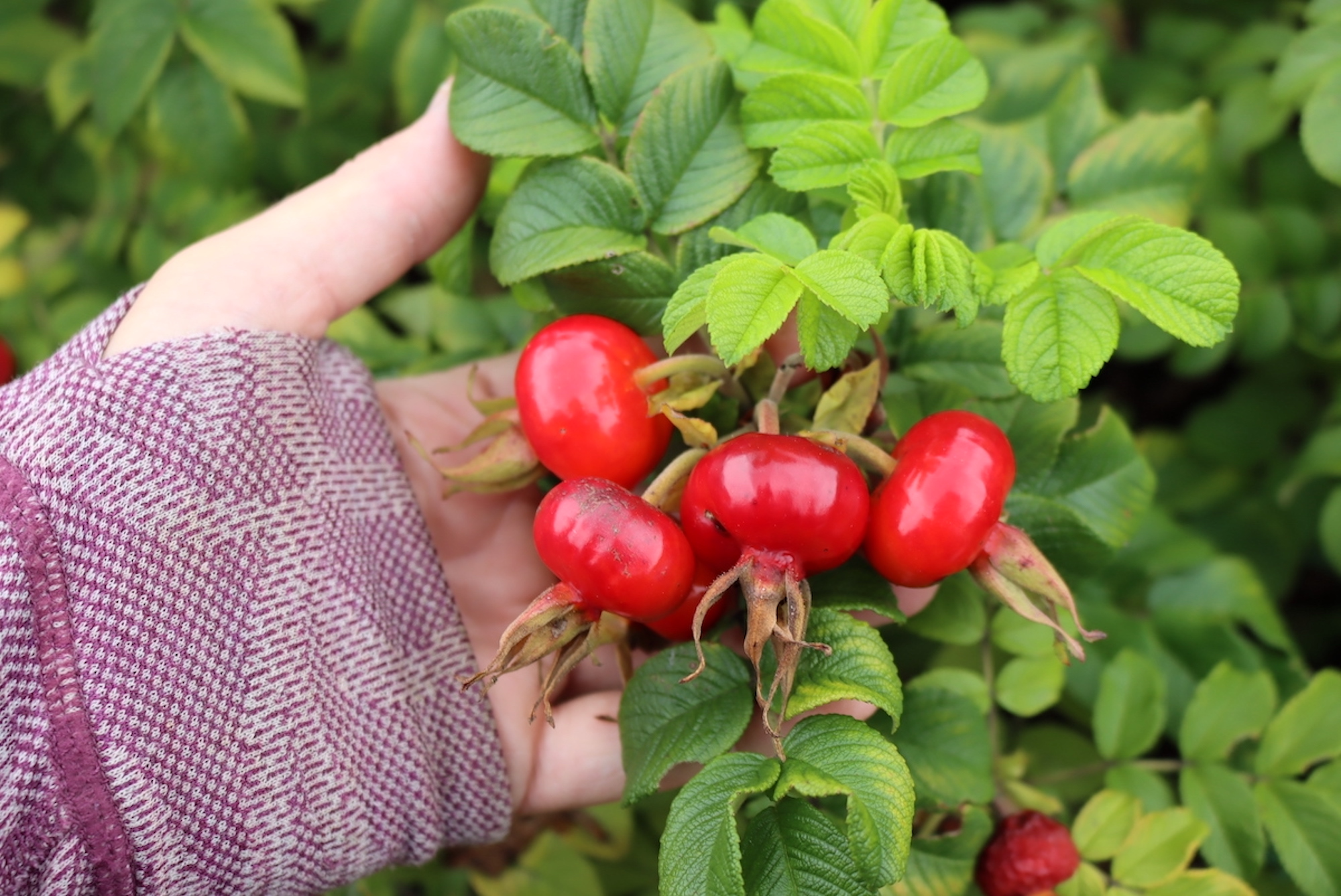
My daughter absolutely loves roses of all kinds, especially fragrant wild roses that we find on our hikes. She’ll “stop and smell the roses” at any opportunity, but before she strikes out again, she always says, “Mama, we have to come back here in the Fall for rose fruits!”
Rose hips, or “rose fruits” as she calls them, are an extra special treat. As with any wild fruit, some taste better than others, and we have all our favorite spots for the sweetest, most flavorful rose hips marked out in our mental map…and each fall we do a tour harvesting for all manner of tasty treats (and remedies).
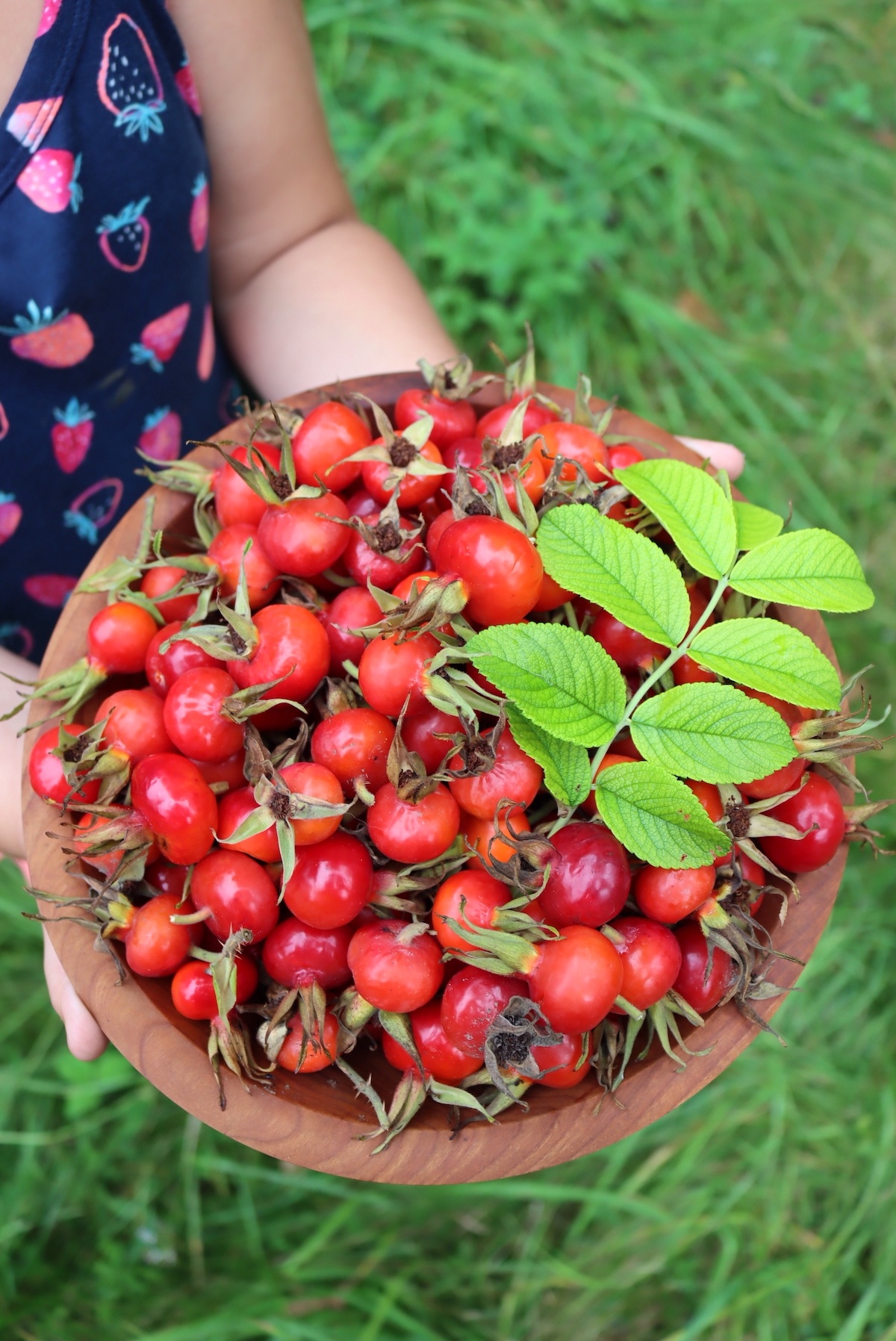
The best-tasting rose hips are a bit like an apple, sweet and crunch, with a hit of acidity and an almost tropical fruit flavor. Others are a bit more tannic and abrasive, but you never quite know until you try them.
I think that’s part of the appeal for my little one. You never quite know what you’re going to get, and after testing out wild rose hips all over our region, we’ve yet to find one she didn’t like.
I know they have a reputation for being tart, and maybe we’re just lucky, but even as a toddler, she’d gently use her teeth to scrape back sweet rose hip flesh off of any wild rose hip she found, always exclaiming, “I love rose fruits!”

The fruits themselves are just a thin layer of fruit flesh over a pocket of seeds, and the seeds aren’t particularly tasty.
If you do test your rose hips wild in the field, be sure to do as I’ve trained my littles to do…gently scrape back the flesh all around the seeds…and then toss the seeds back where you found them (or in another suitable spot) to grow again.
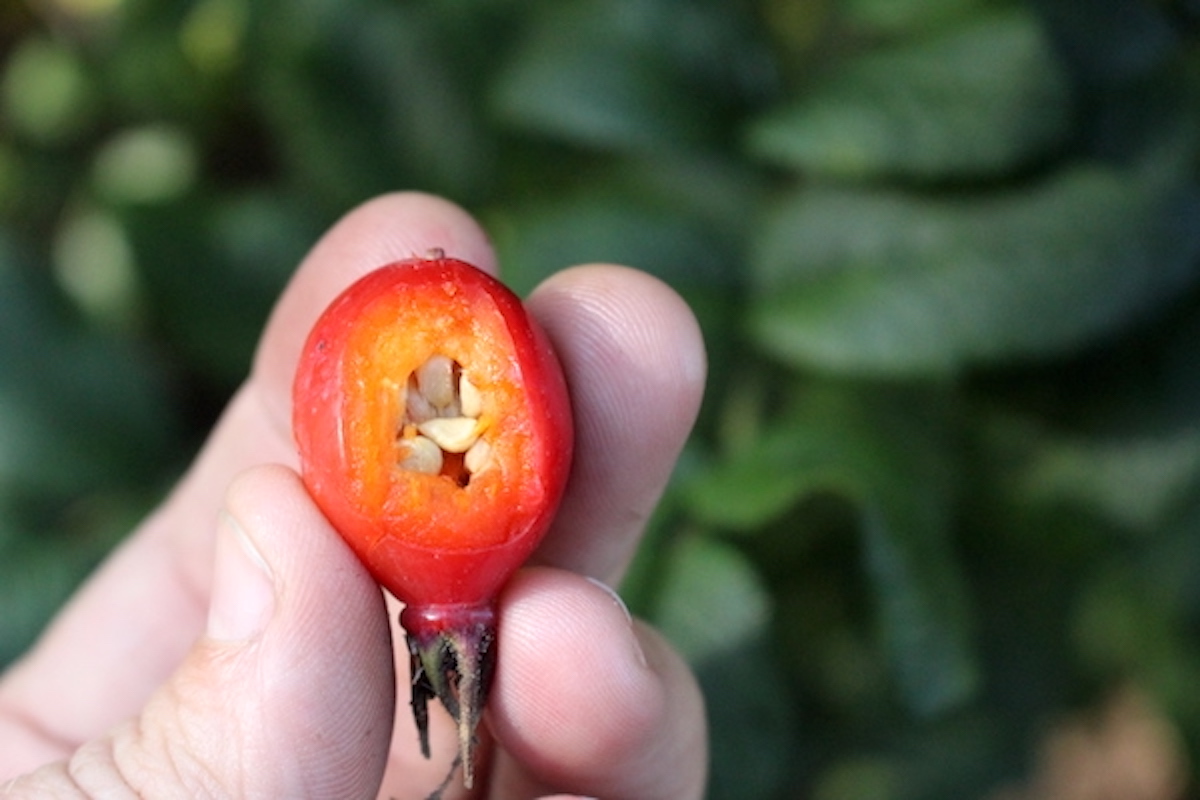
What are Rose Hips?
Rose hips are the fruits of rose bushes, wild or cultivated.
Rose is a woody, perennial flowering shrub in the Rosaceae or Rose family. There are over three hundred species of Rose. Depending on the species, they may be vining or more shrub-like and vary widely in size.
Most rose species are native to Asia, but small numbers are native to North America, Europe, and northwestern Africa. Today roses are widely grown as ornamental plants outside of their native range. Some of these species have escaped cultivation and become invasive. A good example is Multiflora Rose (Rosa multiflora) which is native to Asia but was introduced to North America, where it’s now considered invasive.
Rose species readily hybridize, and there are thousands of garden cultivars on the market. Some of these cultivars have been developed to grow large rose hips, the accessory fruit the plant produces.

Are Roses Edible?
Roses are usually grown as ornamentals but are all wonderful edible and medicinal plants too! You can safely consume young rose leaves, rose buds, rose petals, and rose hips. You can use them raw or cooked.
Roses are high in nutrients and have various medicinal properties making them suitable for internal and external preparations, including teas, tinctures, glycerites, vinegars, syrups, lotions, and baths.
The rose hips of two species, the Dog Rose (Rosa canina) and the Rugose or Wrinkled Rose (Rosa rugosa) are valued for their exceptionally high vitamin C content.
As the adage goes, every rose has its thorn. Be careful when harvesting roses. Their thorns can cause irritations and scratches, especially in those with sensitive skin.
Always ensure the roses you’re harvesting are not contaminated with pesticides, fungicides, or other chemicals. Gardeners often grow roses strictly for ornamental purposes and may treat them with products and amendments that aren’t food-safe. On the same note, florists often treat roses with chemicals to help them last longer. Don’t consume roses that were purchased from a florist.
Rose Hips and products made from them contain high levels of vitamin C. Due to this, people with sickle cell anemia, recurring kidney stones, or hemochromatosis should avoid consuming excessive amounts.
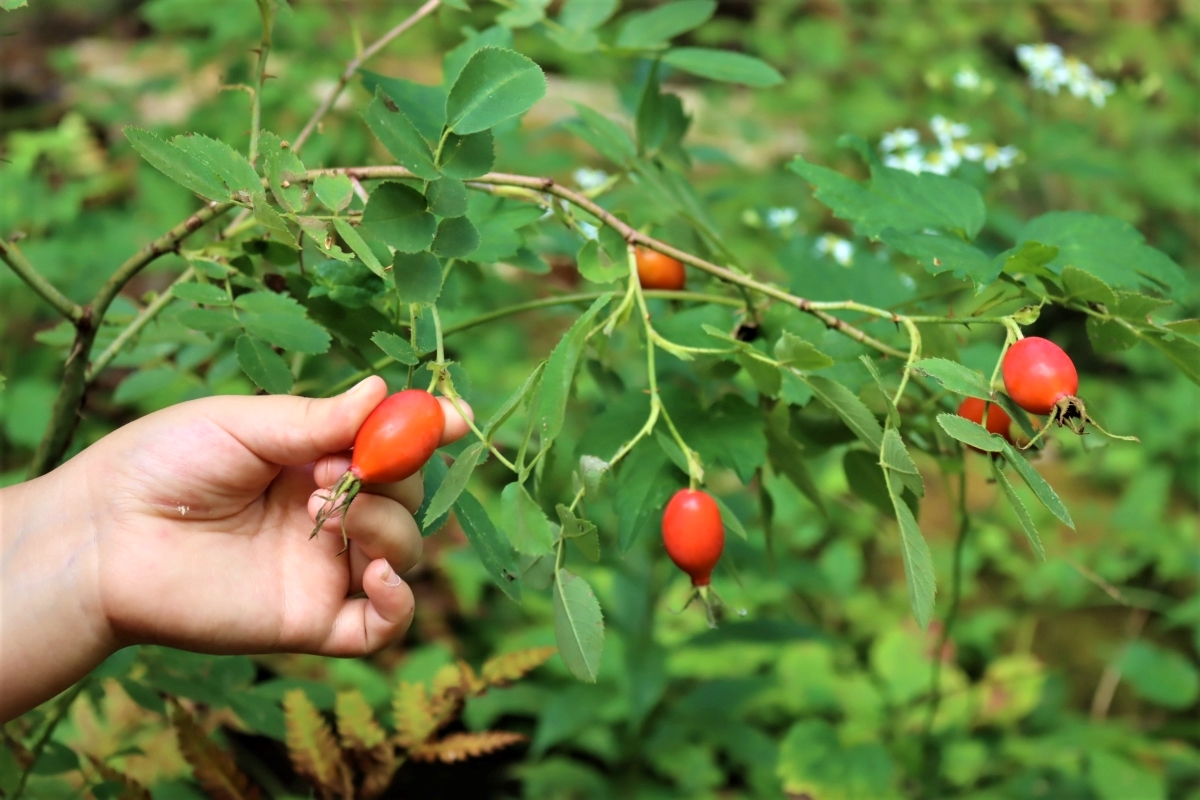
Rose Hips Medicinal Benefits
Roses are nutritional powerhouses. Rose hips are well known for their high levels of vitamin C, but they’re also a great source of antioxidants and contain other essential vitamins and minerals. The petals also contain vitamins C, A, D, E, & B-complex and minerals such as zinc, iron, and selenium.
Herbalists attribute roses with antiviral, antibacterial, anti-inflammatory, antidepressant, and mood-enhancing properties. Herbalists may use roses in various internal remedies for treating sore throats, colds, flu, heart disease, UTIs, ulcers, headaches, diarrhea, constipation, ulcers, and hypertension.
Modern science has supported herbalists’ use of the plant for treating heart disease. Researchers found that patients who drank rose hip tea daily for six weeks saw numerous heart health benefits, including significant reductions in blood pressure, total cholesterol, and LDL (bad cholesterol).
Modern studies have also explored the use of rose hips in treating osteoarthritis pain. A 2019 review of 24 studies indicated that rose hips may help reduce oxidative stress and inflammation in the joints, helping to relieve the symptoms of osteoarthritis.
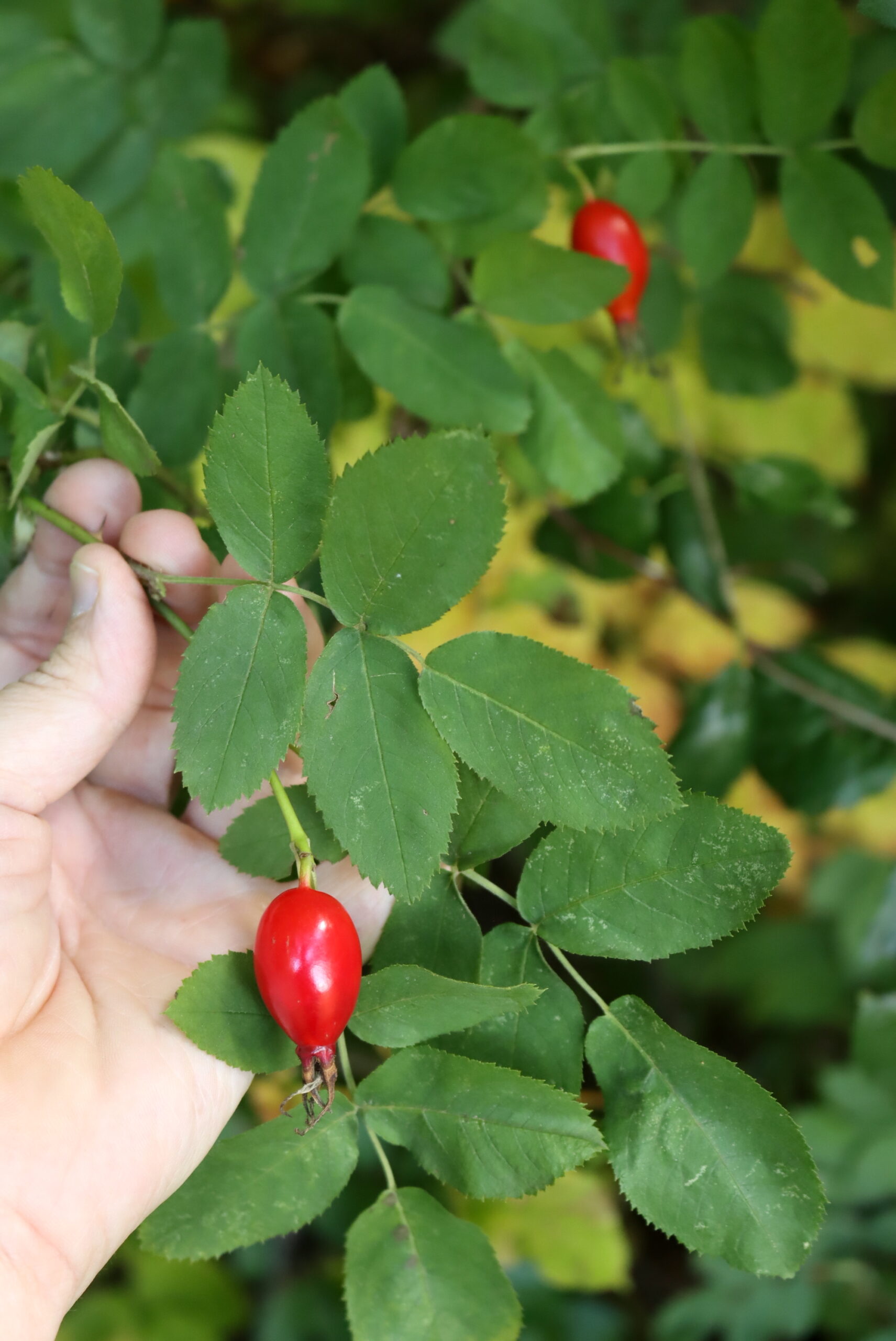
In some cultures, herbal medicine practitioners also use rose petals and rose hips in tea for female disorders like menstrual cramps and heavy, painful periods.
Herbalists may also use roses externally. They may have anti-aging and soothing properties, so herbalists employ them to treat sunburn, acne, eczema, and bug bites, as well as in daily skincare and anti-aging treatments.
Taking rose hips internally may also help improve skin health. One 8-week study found that participants taking rose hip powder saw decreased wrinkles and increased skin moisture and elasticity.
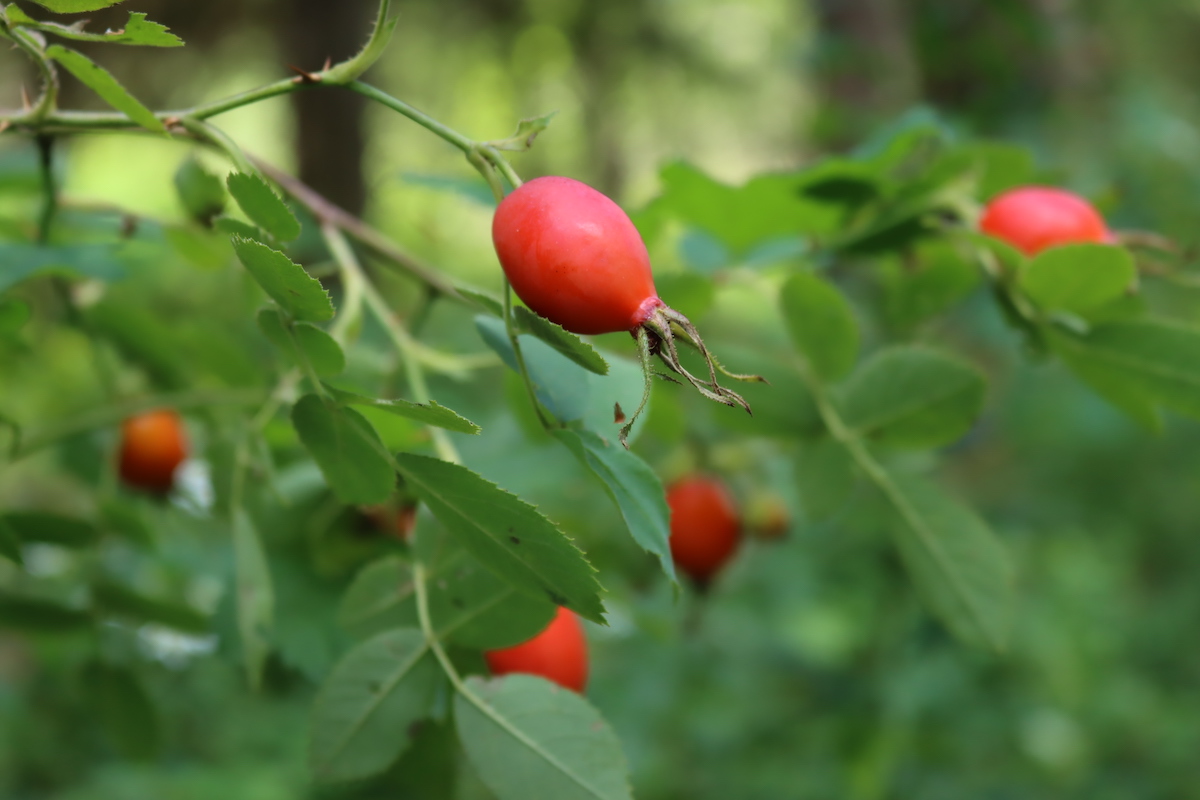
Where to Find Roses
There are over 300 species of rose, most of which are native to Asia. However, there are also a few species that are native to North America and Europe. The extensive range of species is found over an equally vast range of habitats, growing virtually anywhere they can get enough sunlight. Most rose species prefer well-drained, slightly acidic soil.
In North America, you may spot roses growing in various habitats, from seasides to woodlands.
The Rugosa or Wrinkled Rose (Rosa rugosa) grows in seaside thickets, sand dunes, and roadsides.
The Prairie Rose (Rosa arkansana) grows in prairies, roadsides, and ditches.
The invasive Multiflora Rose (Rosa multiflora) grows in fields, woods, and roadsides.
These are just a few examples.
Most cultivated roses need at least 6 hours of sunlight daily and nutrient-rich, moist, well-drained soil. You’ll find them in yards, parks, and occasionally open woodlands or old abandoned farmlands, where they sometimes mark the remains of old homes and gardens.
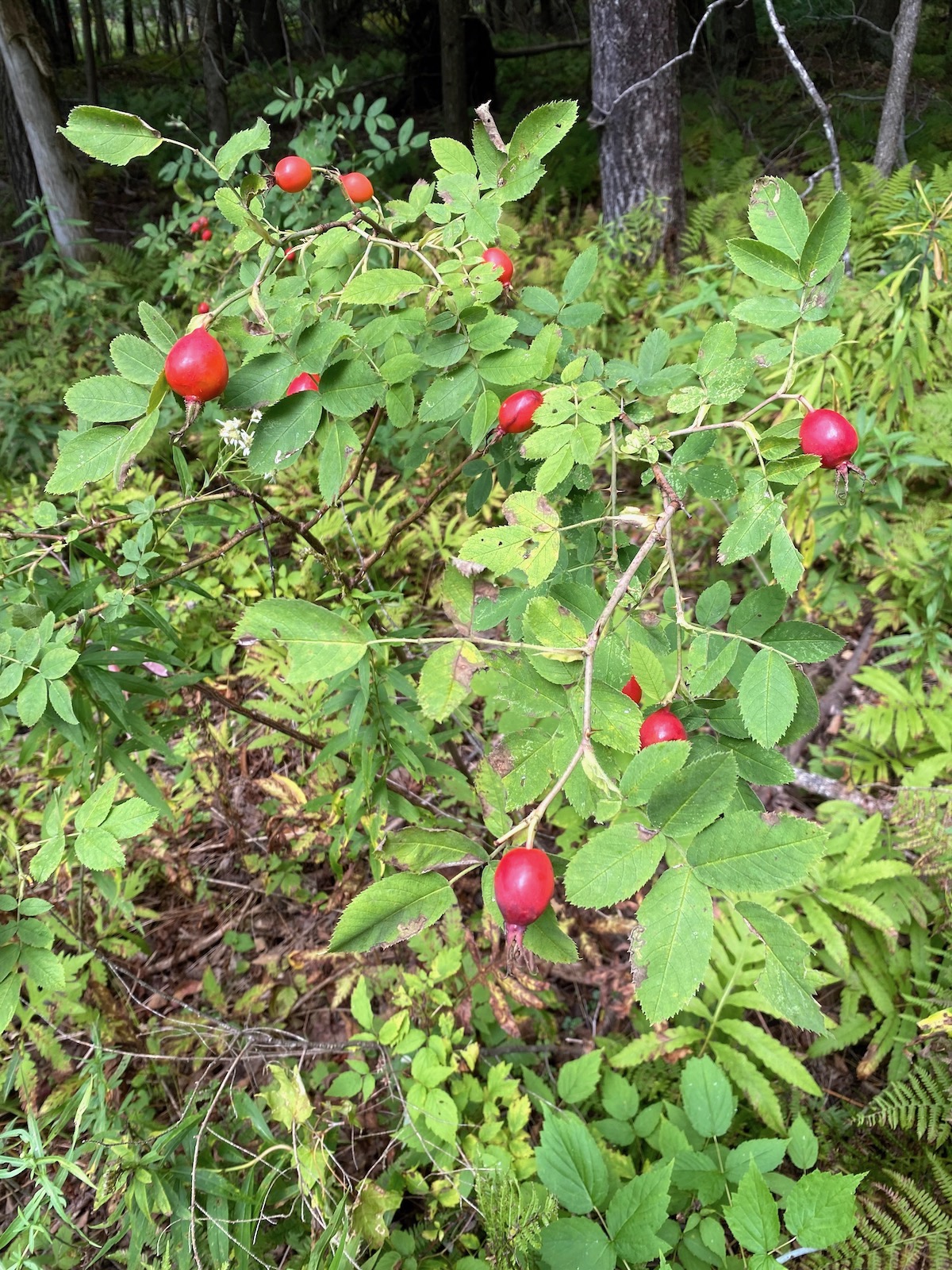
When to Find Roses
Roses are perennial but deciduous, meaning that they lose their leaves in the fall, often in October or November, depending on the climate. Sometimes, you’ll still find some rose hips on plants long after the leaves have dropped. This long-lasting feature makes them excellent winter food for birds and foragers alike.
Bloom periods vary greatly over the over 300 species and thousands of rose cultivars. Typically, roses bloom somewhere between late spring and early fall. Some may only bloom once and briefly, while others will bloom multiple times throughout the year. The petals should be harvested when the flowers have first opened, and they’re fresh and in good shape.
The blooms give way to fleshy, accessory fruits called rose hips. The rose hips usually start green and then ripen to orange or reddish.
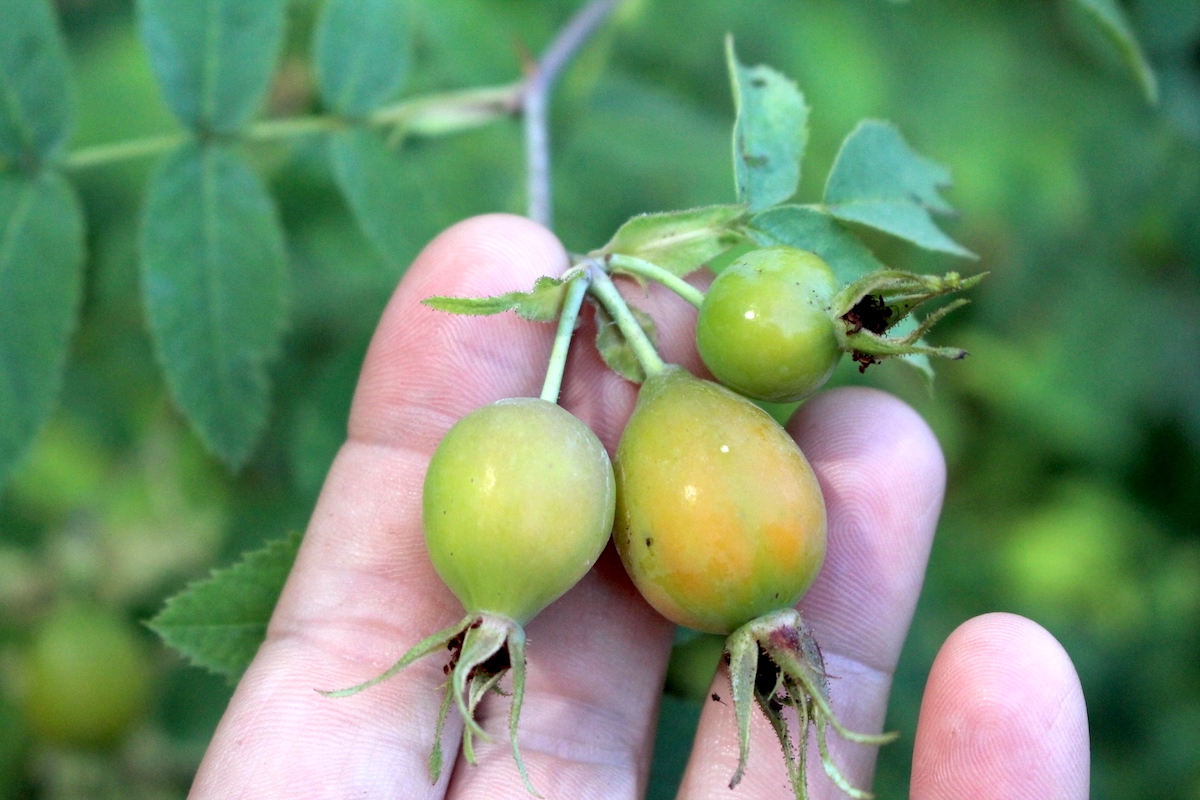
Many foragers and herbalists find the rose hips are best after a light frost, but they can be harvested anytime they’re bright red in color.
Here in Vermont, rose hips start ripening in late August, but we usually harvest them in September and early October.
A light frost or two will bring out their sweetness and drop the acidity a tiny bit. After too many frosts, they turn soft and aren’t quite as good, in my opinion. Still, they can be harvested all winter long, and I do sometimes harvest them for tea in mid-January.
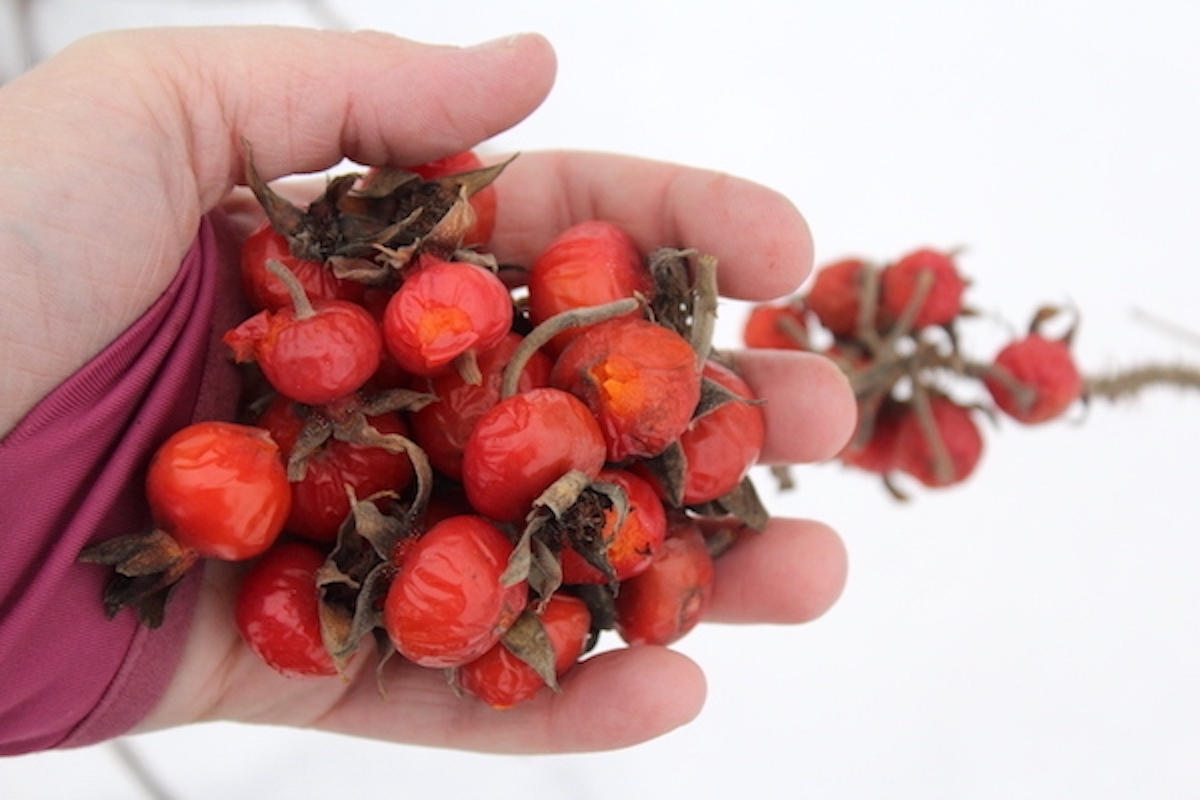
If you want to harvest rose hips en-masse for recipes or herbal preparations, then I’d suggest harvesting them earlier rather than later. Once frosted, they may taste a slight bit sweeter, but they also lose a bit of their acidic Vitamin C content.
They also won’t keep as well after they’re been softened by a frost (unless they’re kept refrigerated or frozen, as they are in nature to preserve them in the winter). If harvested a bit earlier, they’re higher in vitamin C, and they’ll keep a few weeks on the counter top (as you’d keep an apple).
Then you can slowly work through your harvest, and turn it into jam, jelly, wine, or whatever your heart desires. (Or simply dry them for wintertime teas.)
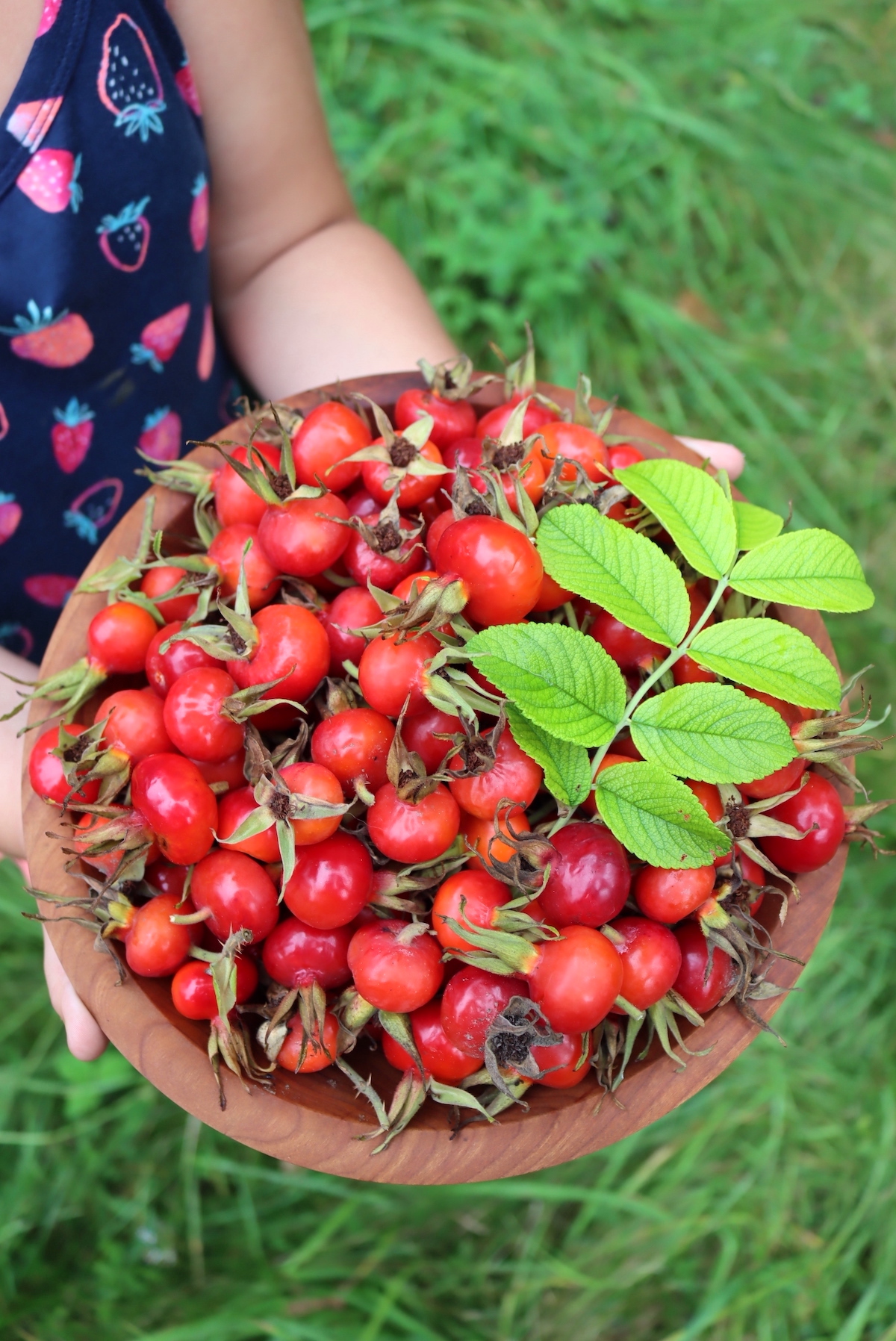
Identifying Roses
Roses range from tiny shrubs to large climbing or rambling vines up to 50 feet long. Generally, they’re known for their large, showy flowers ranging in color from whites and pinks to yellows and reds, but some wild roses, like the Multiflora Rose (Rosa multiflora), have small, white, less-showy flowers.
While some species may vary significantly in appearance, all Roses have alternate green leaves, greenish stems, and thorns.
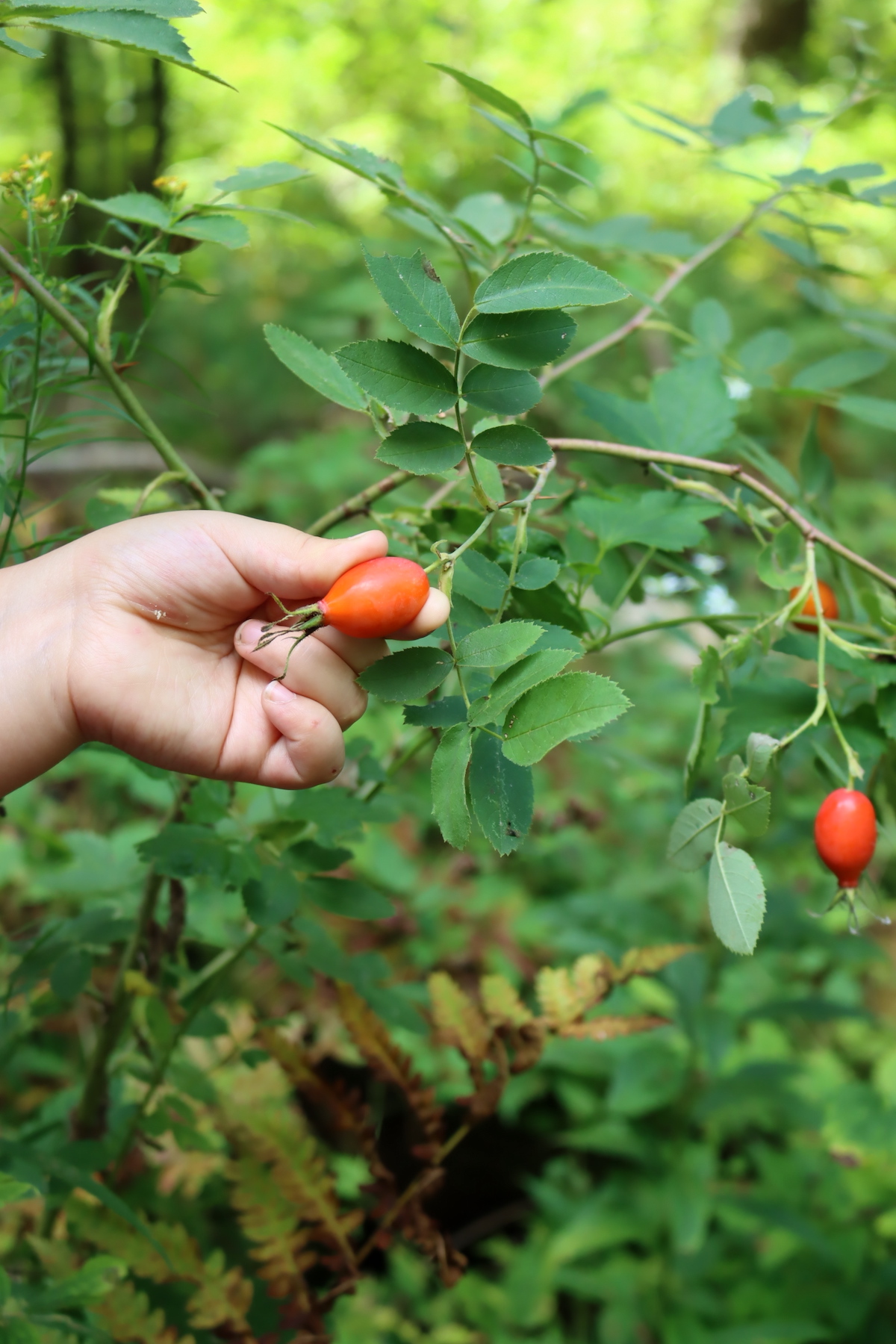
Rose Leaves
Roses have green, pinnately-compound alternately arranged leaves. Depending on the species, they are usually between 2 and 5.9 inches long.
Each leaf is typically composed of 3 to 13 leaflets. Each leaflet is ovate, oblong, or elliptical and has serrated margins and a few sharp prickles on the underside of its stem.
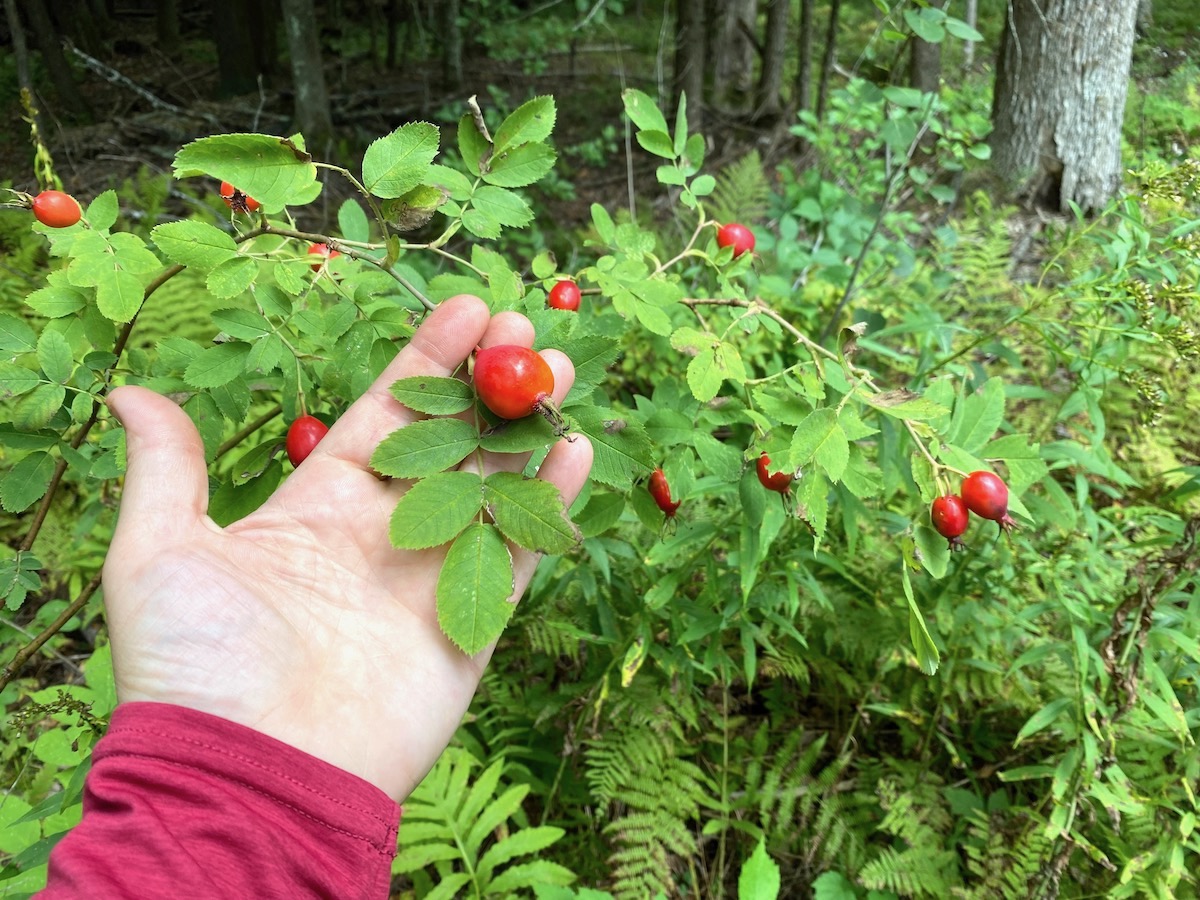
Rose Stems
Rose stems are relatively slender and woody. They’re usually green but may also be reddish or brownish. They may be shrubby, just one to six feet tall like the Virginia Rose (Rosa virginiana), or long and vining up to 50 feet long like some climbing cultivars available today. The stems feature hooked or sickle-shaped thorns.
Rose Flowers
Rose flowers vary widely in size and color. They may be shades of white, yellow, orange, pink, or red. Some, like the flowers of the Multiflora Rose (Rosa multiflora), may be very small, ¾ to 1 ½ inches wide, while the largest recorded bloom was a whopping 33 inches in diameter…but that’s a highly fertilized cultivated blossom. Most wild roses will be 3 inches or less in diameter.
The majority of wild rose species have five-petaled flowers, but some, especially those spread from cultivated blossoms, can have many more petals.
There are a couple of exceptions which have fewer petals. The Silk Rose (Rosa sericea) and a Chinese species called Rosa omeiensis have four petals. Each petal is divided into two lobes.
Beneath the petals, the flowers have five sepals (or, in the case of some Rosa omeiensis and Rosa sericea, four).

Rose Hips
Rose hips are a fleshy accessory fruit produced by roses. These fruits typically contain 5 to 160 seeds embedded in fine stiff hairs. Most rose hips start as green and ripen to an orange or reddish though they may be yellowish or dark purple to black like those of the Burnet Rose (Rosa pimpinellifolia).
Rose hips vary in size with species. Many of the varieties favored for rose hip production have larger hips, about ½ in size. I’ve seen some species of wild rose with hips up to 1 1/2 inches, so they can get quite large.
Note that some domestic cultivars don’t produce rose hips. Their petals are two tightly formed to allow pollination. If grandma’s extra showy double roses aren’t producing rose hips, that’s probably why.
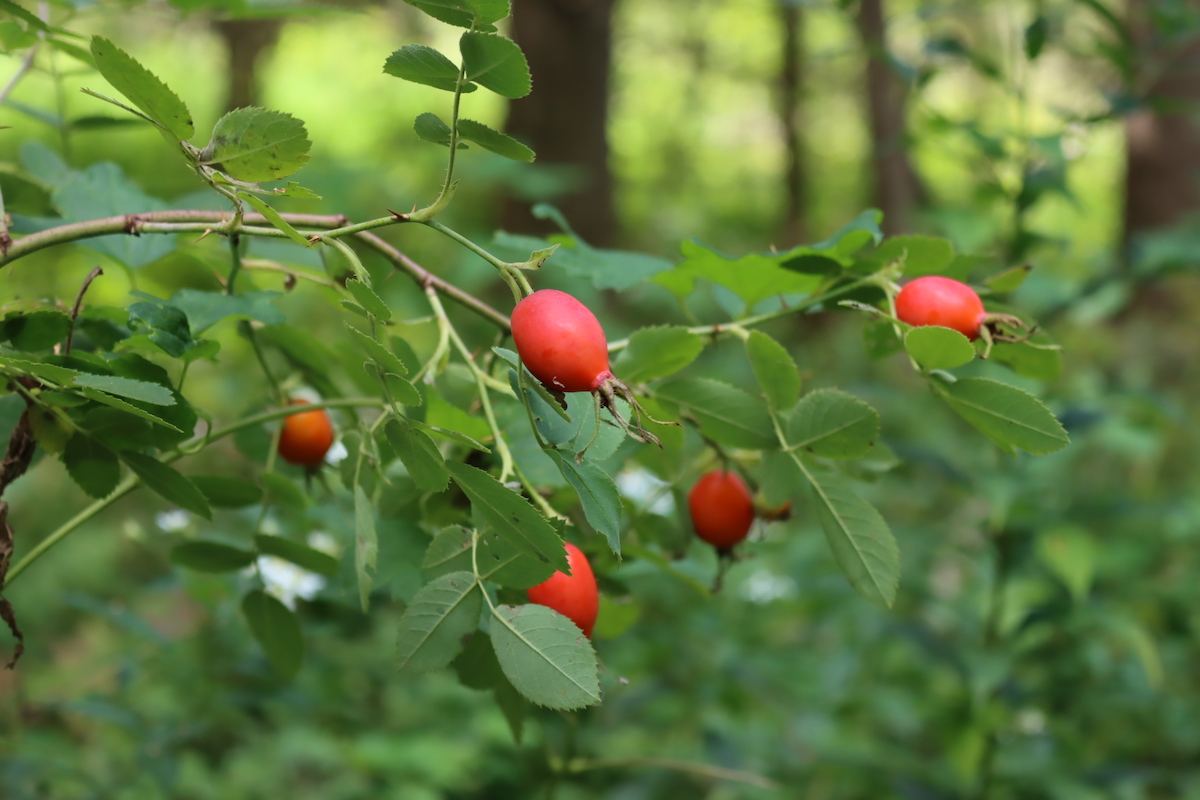
Rose Look-Alikes
Rose flowers resemble another common garden flower, Ranunculus (Ranunculus sp.). However, Ranunculus differs in a few noticeable ways:
- Ranunculus are herbaceous plants that typically grow to just 20 inches tall and 6 to 12 inches wide.
- Ranunculus blooms are unscented.
- Ranunculus typically has leaves forming a rosette at the base of the stem.
- Ranunculus lacks thorns.
- Ranunculus doesn’t form hips.
Another look-alike is Thimbleberry (Rubus odoratus) in the eastern U.S. and (Rubus parviflorus) in the western U.S.. It can be distinguished in the following ways:
- Thimbleberry has large, simple, palmate leaves.
- Thimbleberry stems are thornless and have brown, yellowish, or grayish bark.
- Thimbleberry produces shallow, raspberry-like fruit rather than hips.
Foragers also need to be careful not to confuse rose hips with the similar-looking red fruit of Red Chokecherry (Pyrus arbutifolia). Thankfully, there are a few simple ways to differentiate the two:
- Red Chokecherry is a fairly large, spreading shrub that grows up to 12 feet tall.
- Red Chokecherry stems lack thorns.
- Red Chokecherry has simple, toothed, broadly lanceolate to oval leaves.
- Red Chokecherry leaves are densely hairy and pale beneath.
- Red Chokecherry forms clusters of white or pink-tinged flowers on hairy stalks.
Preparing Rose Hips for Recipes
Rose hips are generally seeded before they’re used in recipes. This is not strictly required, but it’s recommended.
The fruit of the rose hip is on the outside, and the inside is a little pocket of seeds. The seeds themselves are surrounded by tiny hairs that can be irritating to the digestive tract.
Some people can eat them whole with no problem, but others find it uncomfortable.
Personally, when I’m eating them in the wild, I just carefully eat the tasty fruit off the outside of the seeds and then toss the seeds back so they can grow again.
At home, they’re easy enough to seed by slicing them in half and then scooping out the seeds. This works really well in recipes where you’re going to use the whole fruit, like rose hip jam.
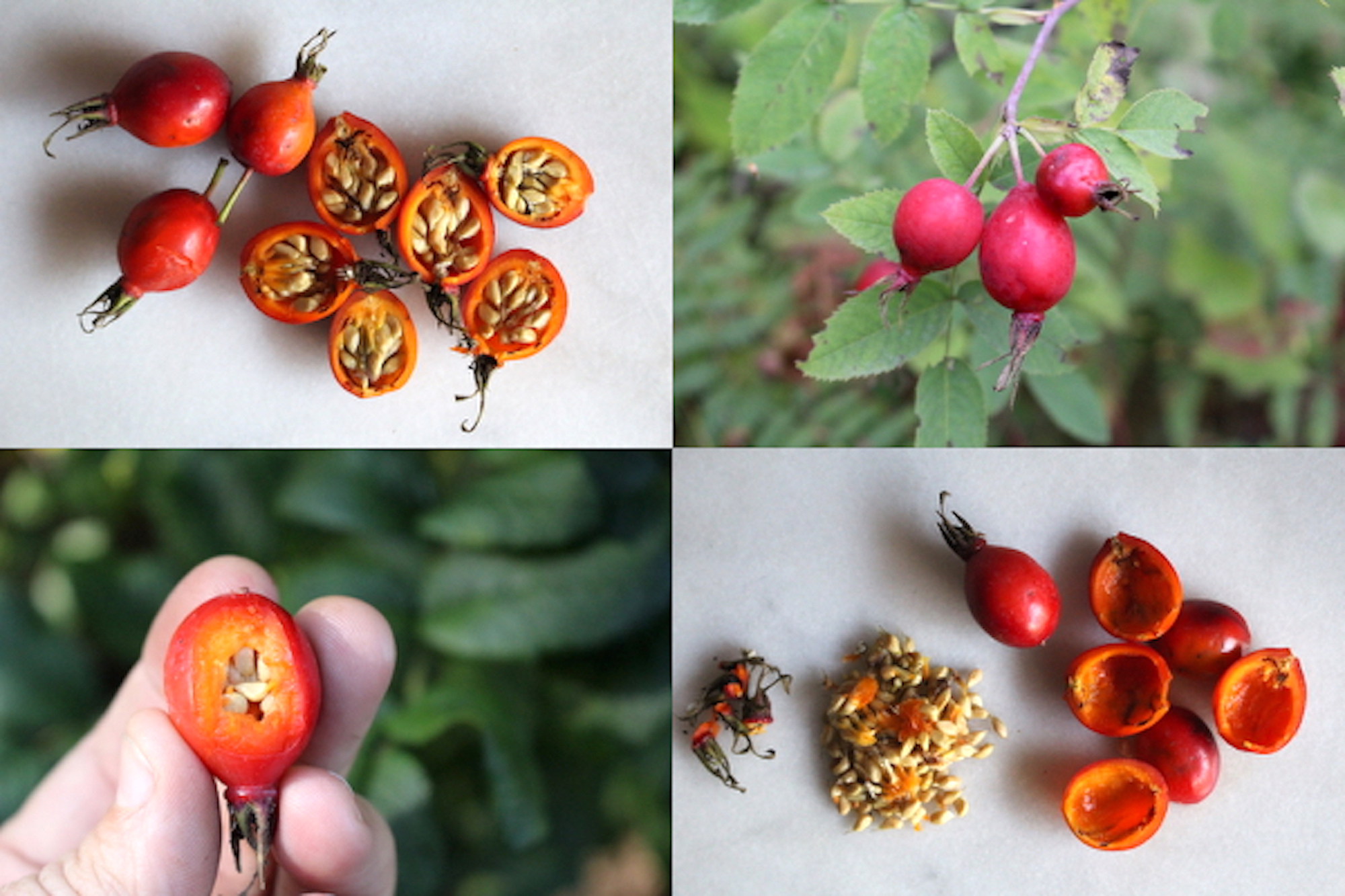
Sometimes, you’re just using a tea made with the rose hips, where the fruit is strained out. Things like rosehip wine, rose hip tea, and rose hip syrup don’t necessarily require hand seeding since you’re going to strain out all the solids anyway.
Similarly, rose hip liqueurs and tinctures are infusions, and the hips themselves are strained out.
If you don’t want to bother with seeding your rose hips, then opt to use them in some kind of tea or infusion.

Ways to Use Roses
Though they still have a place in many gardens, roses have lost their place in our kitchens and medicine cabinets. It’s time to start using these tasty herbal allies again!
Rose hips are known for their high vitamin C content and are usually the most sought-after part of the plant. Their pleasantly tart flavor makes for excellent teas, syrups, and preserves. Middle Eastern cuisine sometimes uses rose hips in jellies, syrups, and marmalades. They also make a tasty addition to sweet desserts like chocolate truffles, cake, and ice cream.
Rose petals also deserve a place in the kitchen. You can use them fresh or turn them into rose water for various dishes. Try them in tea, baked goods, beverages, rose jelly, or infused in honey. Rose water is highly versatile, and you can use it for marinating chicken and veggies, crafting cocktails, or making candy and baked goods.
When taken internally, rose hips, petals, and leaves have many health benefits, from helping to prevent heart disease and improving skin health to decreasing osteoarthritis and menstrual pain. You can use roses to make teas, tinctures, elixirs, extracts, and powders.
Externally, roses are a fantastic choice for homemade cosmetics and skincare. They may help reduce wrinkles, improve skin health, and soothe burns and irritations. Use rose petals or rose hips to make your own soaps, lotions, oils, cleansing sprays, and sugar scrubs.
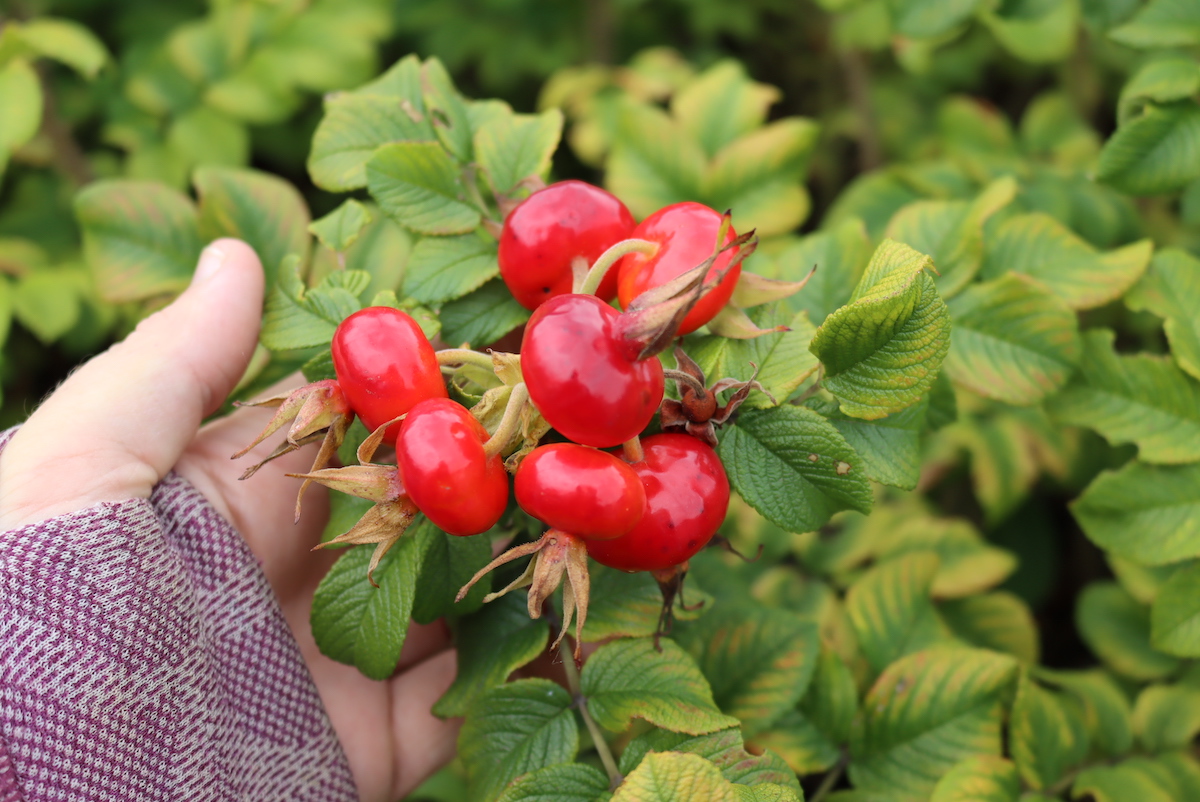
Rose Hip Recipes
I’ve collected all my favorite rose hip recipes into a guide, but here are a few to get you started:
- Whether you need immune support or a tasty addition to ice cream or cocktails, Grow Forage Cook Ferment has you covered! Try Colleen’s recipe for Rose Hip Syrup.
- Rose hip wine is incredibly delicious and bottles up the fresh taste of rose hips along with their medicinal benefits.
- If you want to incorporate roses into your herbal practice, Hawthorn & Honey has three great herbal recipes for Rose Hip Elixir, Vitamin C Balls, and Rose Hip Electuary.
- Try this street recipe for Turkish Doughnuts with Rose Hip Syrup from the LA Times for a fun treat.
Rose Recipes
Have a lot of roses? These rose recipes will keep you busy, and there are just so many ways to eat a rose! (Plus, they have cosmetic uses too!)
- Rose Petal Wine (and Mead) are great ways to drink your flowers!
- Use this Homemade Rose Petal Jam recipe from Feasting at Home to preserve some.
- Make your own rose water for room sprays, hair sprays, or cosmetic products with this simple recipe from Fare Isle.
- Create a stunning masterpiece of a cake with this Rose Cake recipe from Sugar Geek Show.
- Looking for a fun summer beverage? Try this recipe for a Rose Lassi from Dassana’s Veg Recipes.
- Add roses to your skincare routine with this DIY Rose Body Lotion from Country Hill Cottage.
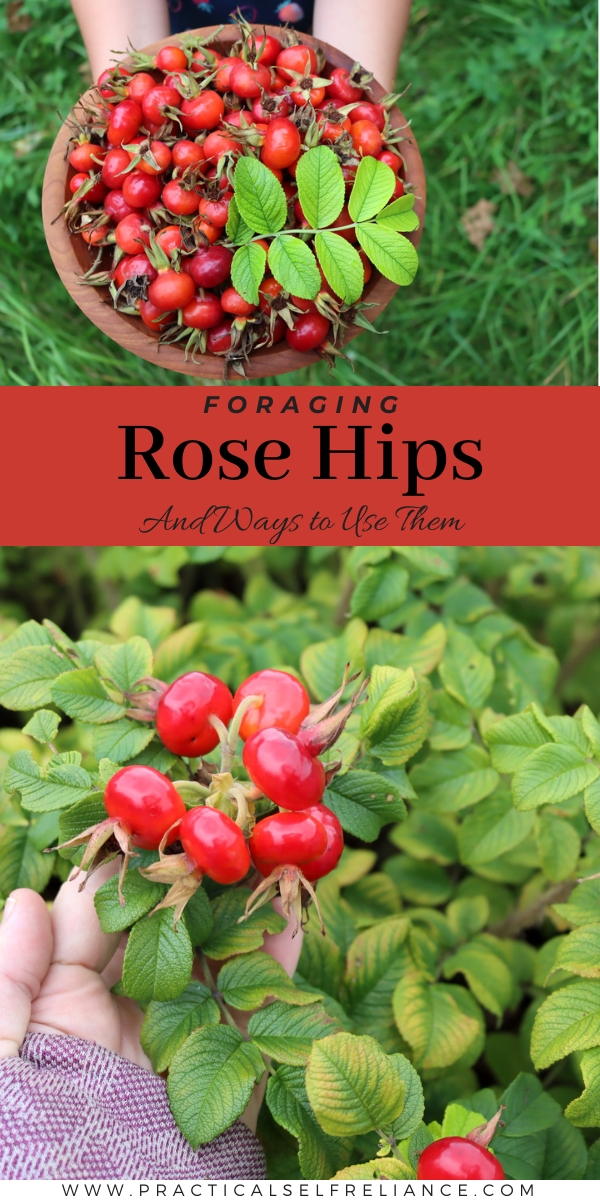



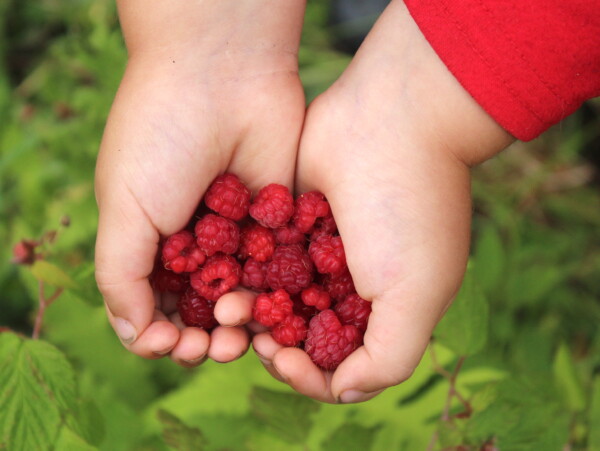










What do you do if your rosehip has worms in it? Toss the whole thing?
Probably? You’ll have to use your best judgement here. I’ve never actually seen rosehips with worms in them, but it makes sense that it would happen.
Nice clicks and thanks for the detailed explanation. Made me think about the times I went hunting for stuff in the bushes close to our home. Nowadays it’s hard to find such spots in the city.
Yes, and you have to be careful because everything is so heavily sprayed now.
Do multiflora rose tips taste good? A lot grows near me and I thought I might try them to lower the amount of seeds it drops.
Yes, they have a good flavor. The biggest issue is that they’re a lot smaller so it takes more but the quality is the same.